
17 minute read
III. The underestimated potential of organics recovery
viewed in France as a new opportunity for a waste-to-energy solution. The process involves recovering rejects from sorting centres or by-products from waste processing (such as woody waste from composting in Madagascar) to produce fuel. Only dry wastes are channelled into this process, which creates an obvious risk of competition with materials recovery activities. In Madagascar, production of these alternatives to wood-fuel yielded 300 tonnes in 2016, earning the recycling company, Madacompost, revenues equivalent to those it earned from compost sales. This also gives Madacompost access to carbon credits, as this valorisation helps to reduce methane emissions.
3. Gasification: at the end of utopia
Advertisement
Other energy recovery methods are also being explored, such as gasification. In Surabaya, a contract was signed for a project to build a gasification power plant in 2018 (Cavé 2016), and solid waste recovery is under study, particularly in Lomé. Following similar trends, discussions are underway in several of Brazil’s southern states1 (notably Paraná) to integrate this technology into their regional waste management plans. Heated low-tech/high-tech debates are taking place around this technology, which is still mastered to a far lesser degree than incineration and used by only a few cities in rich countries (notably Japan) for MSW management. 2 These still costly and globally underdeveloped technologies designed to recover energy mostly from recyclable or compostable wastes may come up against the same limits as incineration in Delhi. In the Indonesian case, the gasification project (still far from completion) is likely to compete with the organics recovery system currently in place (Cavé, 2016). Moreover, this technology, which is highly complex to implement in global North countries (only Japan has developed it on a large scale), is nowhere to be found in global South countries. The main brakes on this method of energy recovery are the types of waste (too wet to be burnt) and the maintenance of the infrastructure, which uses highly sensitive and costly technology. As a result, the risk of dysfunction is extremely high. In addition to the enormous long-term costs incurred, the main risk of an over-reliance on this type of technology is that it may enter into competition with the recovery of recyclables (as it requires the most easily combustible wastes). The example of Delhi shows that the two sectors inevitably experience tensions in the medium-term.
Organic waste should be at the heart of public action as it represents at least 50% of household waste stocks – and in some cities as much as 80%. It thus constitutes the bulk of waste in municipal collection and landfills. Since bio-waste carries potential health risks, it is vital to encourage rigorous local waste management so as to prevent the concentration of pathogenic vectors. Several processing techniques may be envisaged. The first technique is the recovery (via composting or anaerobic digestion) of pre-sorted waste. This means collecting bio-waste at source, which poses many technical and financial hurdles (mainly transport-related), although various methods for composting raw waste are now
1 Solid waste management workshops organised in 2016 in Curitiba by Le Mans University together with
Paranacidade. 2 www.bioenergyconsult.com/gasification-municipal-wastes/
possible when the portion of organic waste is large. The second technique, which is still not officially mainstreamed but holds considerable potential, is decentralised community composting within neighbourhoods. The third organics recovery method involves extracting terreau (i.e., screened dump waste containing biodegraded matter) directly from an existing disposal site. The most effective initiatives implement composting on multiple scales: household, neighbourhood and city. This multi-scale approach means that different waste stocks can be captured using diverse technical and economic mechanisms involving many stakeholders.
1. Composting units: channelling specific streams (green and market waste)
Composting segregated waste: a guarantee of good-quality compost
Delhi’s first composting plant was set up by the municipality in 1985 in Okhla on the city’s southern outskirts. Designed for a capacity of 150 t/day, it proved barely cost-effective and closed down from 1991 to 1995, before a Supreme Court directive ordered its re-opening. Following this, two other composting plants were built in Bhlaswa in 1998 (500 t/day) and in Tikri in 2001 (125 t/day), but proved unsuccessful (they were closed in 2015 and 2013 respectively). Today, the Okhla plant (with a theoretical capacity of 500 t/day) is operated by a private company: the build-operate-transfer (BOT) contract with the municipality provides waste treatment for the city free of charge. It is not operating at full capacity since the incoming waste streams are not homogeneous (sorting is on-site and not upstream), which impairs the quality of the compost (many undesirables), and market outlets are lacking (few buyers). The only way to balance the composting budget would be for public procurement to buoy up the sales price. New legislation provides for subsidies to support compost production and sales. The Ministry of Chemicals and Fertilizers could commit to co-marketing compost and fertilizer: selling 35% of compost and 65% of chemical fertilizer. For the moment, some of the output is distributed to the company, Mother Dairy, which resells the compost at a very high price (19.5 rupees/kg, equivalent to 280 €/t) in its many dairy produce retail outlets across the city. After the “flood of waste” caused by the premature closure of the polluting municipal disposal site at Keputih in 2001, Surabaya municipality rolled out an organic waste recovery policy based on the creation of decentralised composting units and the promotion of household composting. In 2016, 23 composting units were operating across the city with an average capacity of 2 t/day for each unit, equivalent to 19,000 t/year for all units combined (around 2% of the waste generated by the city) (Cavé, 2016). The treated waste comes from the city’s green spaces, the municipal plant nursery and food markets. As the waste streams are homogeneous, the compost is of good quality and used for urban green spaces or given to schools and communities.
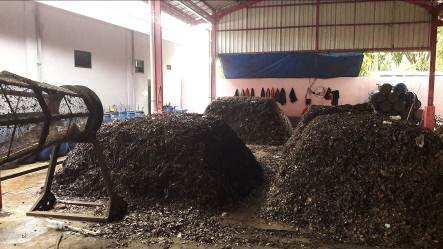
Photo 9.
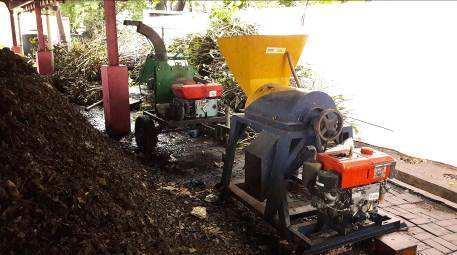
Municipal composting units in Surabaya © Cavé, 2016
Map 7.

Spatial distribution of Surabaya’s composting units Organic recovery is relatively well-developed in Antananarivo compared to other large African cities, as attested by the composting units sited around the wholesale market in
Andravoahangy, in the Amboditsiry fokontany, Antanimena nursery, and in the private composting facility of Vohitra Environnement (Lecointre, Breselec & Pierrat 2015).
In Bogotá, efforts to recover organics from markets are underway. Forty-four food markets have been listed, including 19 owned by the municipality and managed by the Institute for Social Economy1 (Instituto Para la Economía Social - IPES). These markets produce 24,276 tonnes of waste per year, equivalent to a daily total of 67 tonnes. This waste is composed of 89% vegetal organic waste (Hermida, 2014). In this case, the UAESP has partnered with the IPES and FUNDASES (Fundación de asesorías para el sector rural –Foundation to advise the rural sector) to set up a pilot project to recover market waste. So far, only four markets have joined the project: Ferias market, Doce de octubre, Siete de agosto and Quirigua. The recyclables are given to a wastepickers’ association and the organic waste is collected by the company, Compostagro Willys. In return for their participation in the project, the markets receive an 80% reduction on their waste collection bills for avoided costs. Each day, four tonnes of organic waste are collected for composting and vermicomposting at a unit located outside the city (Mosquera municipality). FUNDASES then markets the compost and transfers 15% of its receipts to the UAESP, which then distributes them to residents in the vicinity of the Doña Juana landfill site. This unit lacks the capacity to compost waste from other markets in Bogotá. Thinking is thus underway to develop new composting units of this type.
In Lima, similar waste composting operations only began in 2018 at the initiative of some district municipalities (Comas, Los Olivos, etc.). Results are very different for each of the city’s 43 districts.
Composting raw waste: a viable technique under certain conditions
Composting raw household waste raises the challenge of how to avoid the presence of undesirables (pieces of glass or plastic) or heavy (toxic) metals in the compost output. Given that organising selective collection of household bio-waste is not always easy, the composting chain has to be structured so that the quality of the compost produced is ensured. The following solutions have been tested successfully under Gevalor’s Africompost2 programme in Lomé, Dschang, Mahajanga and Bouaké: - Handpicking on entry to the disposal site: this is done on a table in Lomé, Bouaké and Dschang, and on the ground in Mahajanga. This is negative sorting to remove plastic, glass and hazardous waste (particularly batteries or chemical waste responsible for heavy metal contamination). In Lomé, it also allows the high sand content to be separated out as this would impair the compost quality. To this end, the sorting table has sieve-like holes. The (mainly) organic fraction of household waste available after sorting is then composted. - Continuous handpicking: during the turning of compost windrows (5 to 7 turnings over the composting cycle), the undesirables that had escaped the first sorting are removed. The
1 An institution created by the municipality of the Capital District of Bogotá and dedicated to providing economic support to informal activities. 2 The Africompost project is financed by AFD, FFEM, the Suez Environment Fund and the sale of carbon credits organised by the Good Planet Foundation and the associations Gevalor and ETC Terra. The project supports the development of organic waste composting stations in five large African cities. Sorting and composting helps to improve the local household waste management, while also reducing environmental impacts In parallel, compost production fosters more sustainable local agriculture and brings with it job creation for the most deprived populations.
handpicking and turning thus help to guarantee the compost quality but also incur costs as this work represents the bulk of the labour costs. - Screening on exit: the final screening of the compost separates out most of the remaining undesirables. Depending on the consumers’ requirements, the screening can be coarse or fine (in theory, the latter is more expensive). This nonetheless is likely to reduce the organic matter content of the compost (most of which is present in the coarser elements). This strategy also seems to be used in Delhi where compost products are being developed according to their different levels of quality. - Temperature monitoring helps to assess the level of pathogens in the compost produced. The recorded temperatures serve as a guarantee of the compost’s safety. Analyses carried out in three of the cities show that the concentration of metallic trace elements in lower than the level required by the French standard (NFU 44-051). In the Africompost units, composting the organic fraction of raw household waste is combined with the composting of market, green or agri-food industry wastes to improve the quality of the compost produced.
2. Neighbourhood composting: domestic bio-waste community-led management of
In addition to the municipal composting units, Surabaya municipality has distributed a vast number of domestic compost bins for organic household waste. Between 2005 and 2010, considerable community efforts were made to promote this practice: nearly 20,000 household composting bins were distributed mainly thanks to the involvement of women’s community associations and contests to reward the cleanest neighbourhoods. A study published in 2010 assessed the waste reduction gained by composting at 80 t/day, equivalent to 6% of landfilled waste at the time (Maeda 2010). However, this figure was likely overestimated as some surveys seem to show that only 5% of the composting bins were still used in 2016, meaning that a maximum of 1,500 t/year were actually treated (Cavé 2016). The municipality reported that momentum was waning and that ne activities were needed to raise awareness on composting. The combination of the three approaches in Surabaya City (decentralised composting of green waste, composting of raw waste1 and individual composting) shows the municipality’s real commitment to reducing the amount of waste sent to landfill. Several factors appear to be positive: the composition of the waste (green spaces supply a large fraction of the organics in household waste); Surabaya’s urban sprawl: by increasing the number of small units (500 m2), the local authorities make good use of vacant urban land and helps to reduce waste transport costs. The SuperDepo was set up in the neighbourhood the furthest away from the landfill site in order to reduce transport costs. However, it is not operating at full capacity. The main limit to this approach is that the households involved in community composting are unable to sell it, which is also why composting is not undertaken by waste banks that deal with resalable recyclable waste. Composting is implemented more in line with a vision of collective neighbourhood leadership. One of the composting centres managed by Japanese cooperation is trying to sell the compost, but for the farmers located over 100 kilometres away it is seen as too expensive.
1 Example of composting at the SuperDepo pilot-project.
Photo 10.
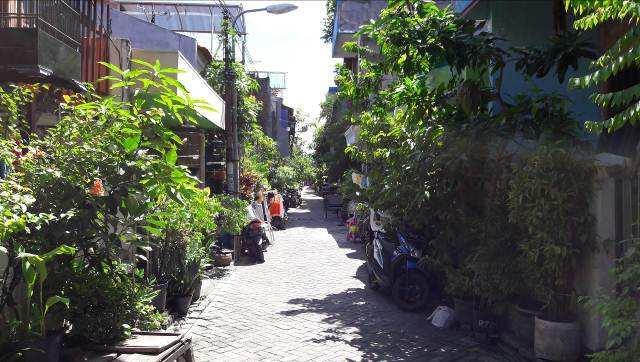
Neighbourhood greening (left) thanks to community composting (right) in Surabaya © Cavé, 2016
In Delhi, there are also one-off experiments in decentralised community composting (Defence Colony – 1,000 households, New Moti Bag – 1,100 households) with source separation of organic waste, but these are on a very small-scale. The Indian Railways company also composts the organic waste from its dining cars, in the city centre. Community composting has also developed around the RF2 primary collection scheme. Several community composting units have thus been created in collaboration with NGOs, such as the unit set up by ENDA1 in 2016 for 50 households in one of city’s districts. With no resources available from city hall, the unit’s success basically depends on ad hoc support from external NGOs. The results thus differ greatly across districts, making it impossible to obtain a quantified view for the whole of the city. There are no statistics on the scale of these initiatives or the tonnages treated. However, “compared with the other cities studied, such as Dakar or Addis Ababa, this type of organic waste recovery is particularly well-developed in Antananarivo” (Pierrat, 2015). Yet it could be surmised that, as in the case of Surabaya, the widespread development of decentralised community composting units could have a significant impact. This is the purpose of the project AULNA (Agriculture Urbaine Low Space No Space) supported since 2011 by the Institut des Métiers de la Ville in Antananarivo, with assistance from the French Institute for Development (IRD), 2 French Cooperation and the Ilede-France Region. The project develops micro-gardens and micro-market gardens in dense, popular neighbourhoods. This type of composting is easy to manage as the compost is reused directly for community gardens (numerous in Antananarivo), whereas a centralised composting unit may well find it difficult to develop a farming clientele willing to buy its compost (mainly due to transport costs).
1 ENDA is an international non-governmental organisation working to fight poverty, preserve the environment and promote citizenship. 2 French public institution for research, expertise, training and knowledge-sharing.
Photo 11.
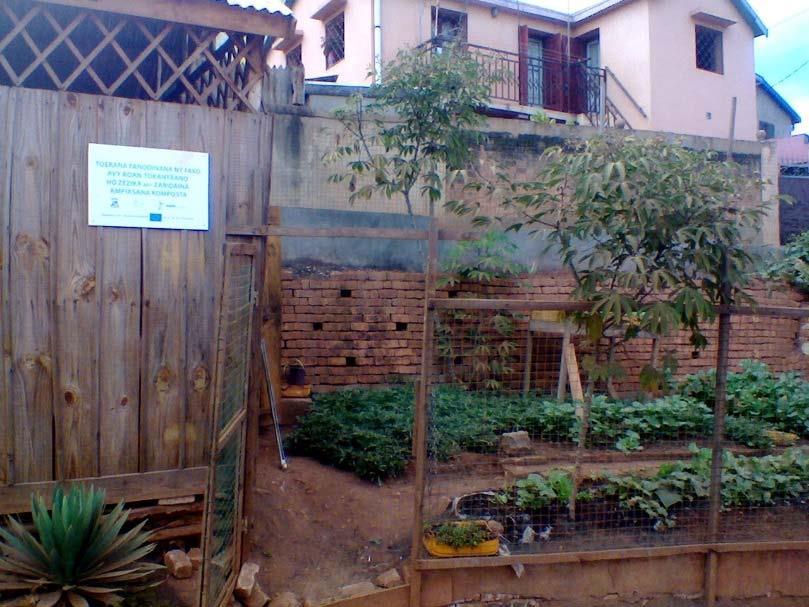
Community composter at the Ambatomaity garden in Antananarivo (50 households) © Pierrat, ORVA2D, 2015
3. The extraction of screened dump waste (terreau)
A poorly controlled but effective product
In addition to composting, organic waste can also be recovered directly from wild dumpsites. In Lomé, degraded material is sieved to produce screened dump waste, also known as “terreau” , a mixture of sand and organic materials. Some dozen micro-businesses are involved in this activity and move around as and when the dumpsites have been treated. Urban growth in the Greater Lomé area suggests that the city will still have a stock of available waste for several years in the future. The main consumers of terreau are people wanting to grow lawns, embassies, some hotels and other luxury complexes for use on their green spaces. The environmental impact of this type of recovery is poorly controlled and not analysis is carried out to ensure the absence of heavy metals and other pollutants. Although terreau is a lowerquality product than compost, it is easier to sell: its affordable price (FCFA 5,000/tonne compared to FCFA 24,000/tonne for compost) suits consumers cultivating ornamental greenery (Garnier, 2016). For terreau producers, it is a highly profitable activity. The quantity of terreau screened by a micro-enterprise can reach up to 3,000 t/year.
Photo 12.
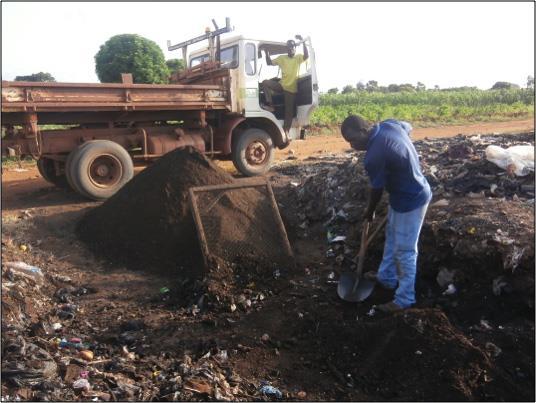
Screening dump waste in Lomé © Gevalor, ORVA2D, 2015
In Antananarivo, terreau production and composting activities have been operating for many years on the landfill site and in the city. The organic content of the waste is very high (nearly 80%) both in household rubbish and the skip containers located near the markets (Raharinjanahary, 2015). Between 1969 and 2002, the on-site operations of the official composting units were often unsuccessful due to problems of design (notably, a dangerous glass-crushing process) and maintenance, which led to insufficient production rates (800 to 3,200 t/year). The site has been organised around the production of terreau. This activity was initially launched with the arrival of Father Pedro and his Akamasoa association, which finds adequate commercial outlets selling to individuals (for market gardening or care of private gardens). A similar offer is proposed by informal workers who settled there in the 1990s. Some twenty informal workers are still on the site. More recently, the private company STOI Agri has developed manual activities for the production of taroka, a product made from a mixture of fermented organics and screened dump waste (95% of terreau enriched by 5% of compost), which is described by its producers as a “high-powered terreau”.
A potential for decongesting landfill sites
Given the difficulty of setting up a composting unit in Antananarivo, excavation of the saturated Andralanitra landfill site, along with production of screened dump waste, is viewed as a viable solution by SAMVA and Gevalor (2015). The old mountain of waste is mostly composed of decomposed organic materials (organic waste in Antananarivo represents 79%). The scenario under study would require excavating 700,000 m³, which would free up space for two additional years of operation. This scenario supposes the construction of a composting unit for raw waste at the site entrance. This would be equipped to treat the bulk of new incoming waste as the quantities to be landfilled would need to be reduced so that the space made available by excavation fills up less rapidly. Three scenarios that combined the composting activity and the excavation project were chosen. The first supposes that 25% of household waste is composted during the excavation works; the second increases this to 50%, while the third aims to treat 100% of household waste by composting. The detailed results are shown in Table 6.
Waste quantities to be buried per
year (raw waste or composting rejects)
Quantities of nontreated waste Volume to be extracted and screened per year to extend the required landfill capacity Increase in the useful life of the landfill if 700,000 m³ are excavated Without a composting unit
174,720 m³
174,720 m³
313,118 m³
2.2 years
If 25% of the waste is treated on a composting unit
148,512 m³
131,040 m³
266,151 m³
2.6 years
If 50% of the waste is treated on a composting unit If 100% of the waste is treated on a composting unit
122,304 m³ 69,888 m³
87,360 m³ 0 m³
219,183 m³ 125,247 m³
3.2 years 5.6 years
Table 6.
Extension of the useful life of the Antananarivo landfill through excavation and composting of incoming waste
Given the estimated volume of waste currently stored on the site (2 million m³), the excavation operation could be renewed twice. If 50% of the waste entering the Andralanitra site were channelled to a composting unit, an extension of almost seven years (2 x 3.2 years) of the site’s useful life could be envisaged, while waiting for the opening of a sanitary landfill. The combination of the two activities nonetheless assumes that the huge quantities of extracted terreau would be used for public projects (reforestation, regeneration of infertile soil, etc.) and not put up for sale. In the contrary case, the sale of the terreau would compromise compost sales given that the terreau would be sold at a much lower price due to its lesser quality for agricultural use. With a view to testing the excavation works, SAMVA conducted a topographical study of the landfill in 2017 and core sampling of the waste mountain to check the composition and safety of the screened dump waste. It will also be crucial to carry out a preliminary excavation pilot project to determine the technical and economic components.










